Eating delicious camping meals is something you should look forward to every camping trip.
However, an important aspect that many campers neglect to consider is proper food storage. Storing perishable and non-perishable foods is essential and necessary in some instances.
Because, the last thing you want is to find is a curious brown bear rummaging through your food supplies looking for that elusive pot of honey…
In this article, you’ll learn how to properly store and secure your food while camping. This way you can keep food fresh and out of reach of pesky woodland critters, even the odd Yogi bear.
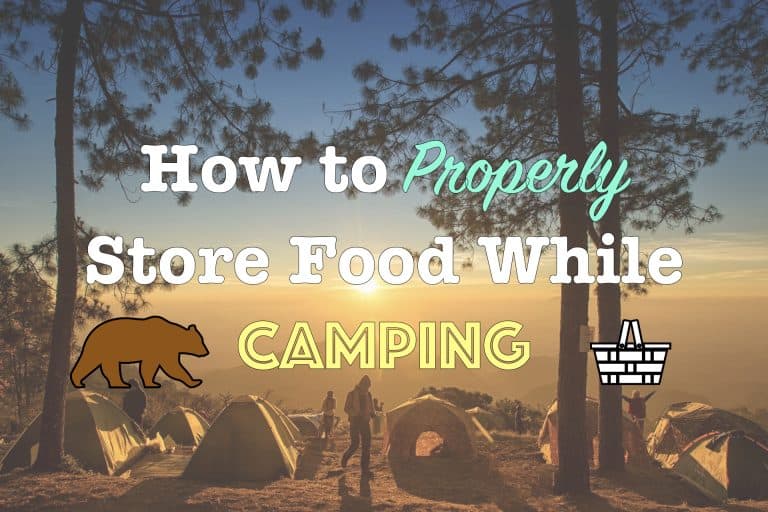
1. Why Food Storage is Important When Camping
Before diving straight into the best food storage equipment on the market, let’s take a step back and ask the question – Why is food storage important when camping?
Well, the two main reasons food storage is important are pretty basic: 1. Preserving perishable goods and, 2. Keeping animals out.
Preserving Perishable Goods
Fresh produce such as bread, meat, fruit and vegetables are sensitive to temperature variations. And, depending on what food you bring, the outside temperature will play a large role in how long it will last. High temperatures tends to spoil foods faster whereas frigid temperatures turn food into solid bricks of ice.
Raw foods such as meat, egg, and dairy can’t handle hot weather well. Therefore, they should be kept in a cool container out of direct sunlight. Bread, fruit and vegetables are more resilient to warmer weather, however, bacteria and mold will develop faster as well.
In cold weather, perishable goods will definitely last longer. This is because cooler temperatures create a natural refrigerator in the woods. The downside is that really cold temperatures can result in food being frozen. So, unless you plan to chisel through an apple, bringing an insulating food storage container will help prevent items from freezing
Keeping food protected from intense heat or cold ensures you can cook and consume everything you bring without any issues.
Keeping Animals Out
Animals are naturally attracted to the food we bring camping because of their keen sense of smell. Raccoons, mice, coyotes and bears can easily sniff out food storage containers.
They can quickly rummage through your goods and make off with anything, from marshmallows to hot dogs. So, to prevent these backcountry bandits from burglar-ing your bacon, it’s important to seal and secure any food you bring.
2. Types of Food Storage Containers
To store food while camping, you typically have two options: Coolers and food canisters. However, the storage option most suited for your camping trip should align with your camping needs.
Before you start packing your food, ask yourself the following questions:
- What type of food am I bringing?
- Is it perishable or packaged
- How much food do I plan on bringing?
- Enough for myself or a family
- What type of camping am I doing?
- Car camping, backcountry camping, canoe camping
The answers to these questions usually point you in the direction of bringing a cooler or a canister, or both!
Coolers
If you are car camping, camping with a large group or camping for an extended period of time, a cooler is definitely your best option.
Coolers are usually designed and built to insulate food from ambient temperatures. They can be filled with ice to keep contents chilled for extended periods. However, because no cooler is a perfect insulator, over time heat can make its way inside, melting ice and warming perishables.
Coolers can also act as a secure storage unit. Precious cargo like beer and bacon can be safely stowed with latches and locks to keep out wandering freeloaders and moochers.
Coolers come in all shapes and sizes. Small, ultra-portable ones for picnics. Large, multi-compartment ones for tail-gate parties. Handles, wheels and latches also features to consider. Some have built-in cup holders and even battery banks for charging electronics!
Canisters
Food canisters are designed to store food in a smaller, more portable form-factor, typically for backcountry / backpacking type of camping trips. Typically, they are non-insulated and therefore perishable goods will not last for any extended period of time.
They can be as small as a mason jar or as large as a keg. Usually, canisters are made from durable plastics, with a wide mouth and a screw on lid or clasp. And, some food canisters are rated as “bear-proof”, made from tough and durable materials.
“Food barrels” are a type of food canister that many campers prefer for expedition or portage type of trips. They can be easily carried by a single person and transported to site in a canoe or kayak or strapped to someone’s back.
3. Food Storage Tips While Camping in Bear Country
Depending on the region and season you plan to camp, extra precautions should be made if bears might present.
Although bears mostly avoid humans, they have a keen sense of smell and will be naturally drawn to ANY scent. Therefore, it is imperative that you safely and securely store all food and scented items far away from your campsite when not in use.
Below are 7 food storage tips for camping in bear country:
- Check to see if a bear locker is available at your designated campsite. Use the locker to store food and garbage during the duration of your trip.
- If no bear locker is present, or while in the backcountry, food canisters and coolers should be hung from a tree. This ensures it’ll be out of the reach of bears. Check out the article below for when and how to hang your food while camping for more information.
- Use air-tight jars, bags or containers to pack and store food related products too (i.e. cookware, utensils, etc.). This helps minimize scents.
- Do not leave food scraps at your campsite. Burn, properly dispose or pack scraps and store with them with the rest of your food.
- Do not eat inside your tent. The lingering scent of food from your tent may attract bears and rodents.
- Treat hygiene products such as toothpaste, deodorant, etc. the same as food and follow the same precautions mentioned above.
- When car camping in bear country, be cautious of using your car trunk as a viable storage area for food. Bears have been documented to destroy cars in an attempt gain access to food. I recommend checking with park rangers to see what they suggest.
4. The Best Camping Coolers and Canisters
After scouring over countless reviews and recommendations, as well as my own experiences, I’ve compiled a list of some of the best coolers and canisters on the market. Let’s take a look and see why these ones are so great!
Portable Coolers
Portable coolers should be compact, yet large enough to carry enough supplies for a meal or two. And, because they will be carried around, they should also be fairly lightweight. A collapsible cooler is a fantastic option for camping excursions like picnics or trips to the beach.

CleverMade Soft-Sided Collapsible Cooler
• 30L capacity
• Durable fabric with collapsible design
• Carrying straps
• Additional storage pocket
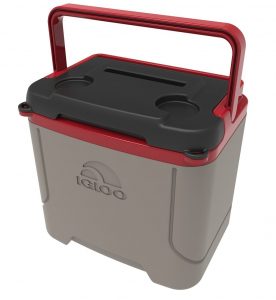
Igloo Profile Cooler
• 15L capacity
• Lockable lid
• Electronics slot
• Built-in cup holders
Car Camping Coolers
A good car camping cooler doesn’t necessarily need to be the lightest or the strongest thing on the market. It needs to easily fit in your car, so optimum dimensions are an asset. Ergonomic handles and wheels are also important for transporting them to and from your vehicle.
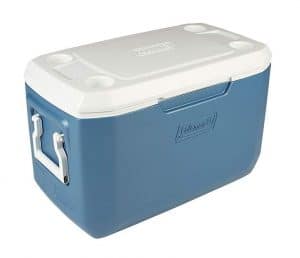
Coleman Xtreme 5 Cooler
• 66L capacity
• Large handles
• Cup holders
• Doubles as a seat

YETI Tundra 65 Cooler
• Lockable lid
• Sealed lid for added insulation
• Heavy duty lid latches
• Quick drain spout for melted ice
Coolers for Large Groups
Group camping and tailgate parties require a lot of food and supplies therefore larger coolers are supreme. Handles and wheels are required since the overall weight of a full cooler can be very high. Also, with larger pieces of equipment, the build quality needs to match.
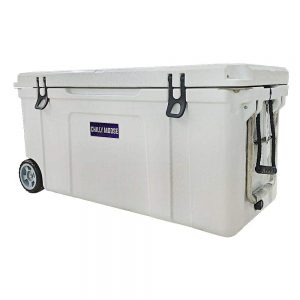
Chilly Moose Chilly Ice Box
• 120L capacity
• Built-in bottle opener
• Rope handles
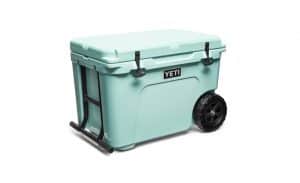
YETI Tundra Haul Wheeled Cooler
• Lockable lid
• Integrated handle
• Built-in wheels
Canisters for the Backcountry
For trips into the backcountry, especially for canoe camping, I always pack food in my 30L food barrel. It has more than enough room for all my food, toiletries and cooking supplies.
It’s built to handle all types of abuse and secure enough to keep rodents and bugs out. The handles allow for easy handling and the ability for it to be hung.
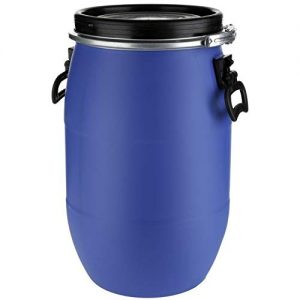
Canoe Food Barrel
• 30 and 60L capacities
• Lever-locking lid
• External handles
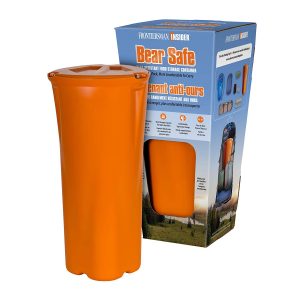
Frontiersman Bear Canister
• 12L Capacity
• Bear-proof construction
• Slim design
• Air-tight seal
Canisters for Backpacking
For backpacking, a food canister must be compact yet allow food to be accessed quickly and easily.
A large, wide mouth with a screw or quick release lid is ideal. They need to made out of durable materials to last through your entire trek and future ones too!

BearVault BV500 Container
• 7L capacity
• Transparent material
Note: Some campgrounds and parks do not consider this container adequate for backcountry camping when bears are present.
This article contains affiliate links, which help support this blog at no cost to you!
